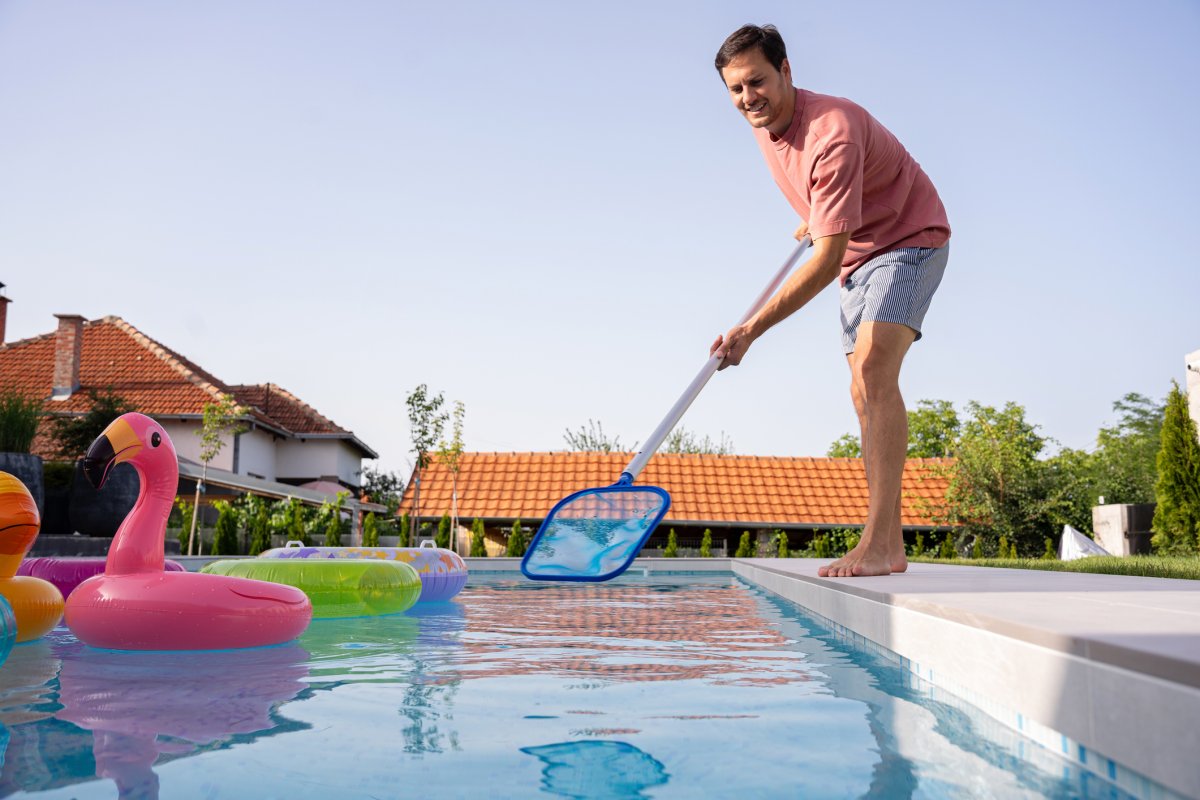

We may earn revenue from the products available on this page and participate in affiliate programs. Learn More ›
Nothing ruins a relaxing swim faster than stepping outside ready to dive in, only to find your pool water has turned neon green or is clouded with dirt and debris. Regular maintenance is crucial for keeping your pool safe, clean, and enjoyable all season long. Unfortunately, many homeowners end up making some common pool water mistakes that can result in expensive repairs, poor filtration, and unsafe swimming conditions. By learning what these mistakes are and how to prevent them, you can enjoy a sparkling, hassle-free pool with far less effort and cost.
1. Not Running the Pool Filter Enough
One common pool maintenance mistake is not running the pool filter and pump long enough each day. Your pool’s filtration system plays a crucial role in keeping the water clean by circulating it and removing debris, contaminants, and critters. If the pump isn’t running consistently, debris can accumulate, water can become cloudy and your filtration system might even become clogged. While you might want to cut back on energy costs by limiting pump usage, this often leads to more expensive problems down the road.
To keep pool water clean and your system functioning properly, it’s recommended to run the filter and pump for at least 8 hours daily—though larger pools might require up to 12 hours to ensure filtering of the entire water volume. Using a timer can help automate the process and ensure consistency. Running the pump during chemical treatments is also essential for even distribution throughout the pool.

2. Not Testing the Water Regularly
Regularly testing pool water is essential to maintaining a clean, safe, and functional swimming environment. Skipping weekly water tests or relying on visual cues to assess water quality can lead to major problems such as algae growth, cloudy water, and damage to pool surfaces and equipment.
Test your pool water at least once a week with test strips or a liquid kit to help monitor critical factors like pH, alkalinity, chlorine levels, calcium hardness, and more. It’s also recommended to bring a sample to a local pool store monthly for a more detailed analysis. Proper testing ensures your chemical balance stays within safe ranges, avoiding issues like skin irritation, corrosion, or equipment failure. Checking pH and alkalinity is especially important, since water that’s too acidic or too alkaline can corrode surfaces or cause scaling and cloudiness.
3. Not Checking and Maintaining Pool Water Levels
Maintaining proper water levels in a pool also is crucial. The water level naturally fluctuates due to evaporation, splashing, and rainfall, and failing to monitor it can affect how water circulates throughout the pool. Low water levels can cause the skimmer to pull in air, risking pump damage, while high levels reduce skimmer effectiveness and hinder proper chemical distribution.
To maintain optimal function, check water levels weekly, keep the water at the midpoint of the skimmer, use a pool cover to reduce evaporation, and add or remove water as needed. We sometimes hear a loud gurgling noise, which means it’s time to add water to the pool. Check more frequently as necessary during hot, stormy summer months and keep in mind that frequent water loss might indicate a leak.

4. Not Cleaning the Pool Filter Regularly
Your pool filter is essential for removing dirt, debris, and contaminants from the water, but it loses its effectiveness when it’s clogged. This can lead to cloudy water, poor chemical distribution, and increased strain on the pump—potentially causing expensive damage and higher energy bills.
Regular filter maintenance keeps your pool water clean and safe, extends the lifespan of the filter, and improves overall system efficiency. Proper care depends on the type of pool and filter you have, so check instructions for your specific filter. In general, aim to clean the filter every 2 weeks, and more often when you have a lot of debris in your pool.
5. Not Keeping Pests Away
One of the most surprising mistakes we’ve made at our pool in Florida is not paying attention to how animals and insects can affect the water. We often see raccoons splashing around in our pool, and they are known to enjoy washing, paddling, and going to the bathroom in backyard pools. Unfortunately, their activities and those of pests like frogs who can’t escape the pool, can end up making the pool dirty.
Certain insects also can wreak havoc on pool water. One time we came home after a vacation and our pool was bright green. We discovered that whiteflies had attacked the Ficus shrubs around the perimeter of our backyard, and these insects can destroy chlorine in the pool.
Whiteflies excrete a sticky substance called honeydew, which falls into the pool. This sugary waste becomes a nutrient source for algae, which thrive in warm, stagnant water. Chlorine and other sanitizers may get used up faster trying to neutralize the organic waste from the whiteflies, which can leave the water under-treated and allow algae to bloom, turning the pool green.
